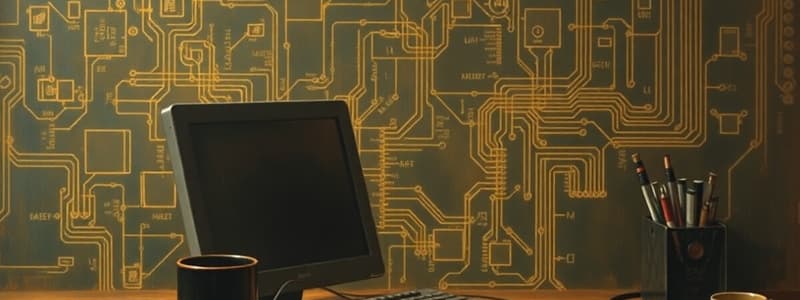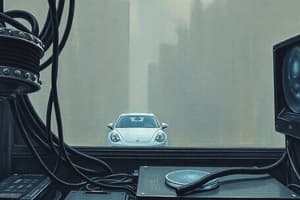Podcast
Questions and Answers
What is the function of the Control Unit (CU) in the CPU?
What is the function of the Control Unit (CU) in the CPU?
- Performs arithmetic calculations
- Manages the power supply
- Moves instructions to storage devices
- Controls processing of instructions (correct)
Which of the following accurately describes RAM?
Which of the following accurately describes RAM?
- A type of primary storage with volatile memory (correct)
- Used exclusively for long-term storage
- Stores firmware for the computer
- Has a fixed size determined at manufacture
What type of computer is designed for complex tasks requiring immense processing power?
What type of computer is designed for complex tasks requiring immense processing power?
- Supercomputer (correct)
- Embedded computer
- Microcomputer
- Mainframe
Which component within the CPU is primarily responsible for logical operations?
Which component within the CPU is primarily responsible for logical operations?
Which of the following is NOT a type of computer system categorized by physical size and processing power?
Which of the following is NOT a type of computer system categorized by physical size and processing power?
The term 'bus' in a computer system refers to what?
The term 'bus' in a computer system refers to what?
What does the stored program concept allow in computer systems?
What does the stored program concept allow in computer systems?
What is the main function of input/output devices in a computer system?
What is the main function of input/output devices in a computer system?
What is the primary function of the BIOS in a computer system?
What is the primary function of the BIOS in a computer system?
Which step comes directly after the Power-On-Self-Test (POST) in the booting process?
Which step comes directly after the Power-On-Self-Test (POST) in the booting process?
What does the Registry store information about?
What does the Registry store information about?
What is the purpose of drivers in context to computer peripherals?
What is the purpose of drivers in context to computer peripherals?
What is the first step in the booting process?
What is the first step in the booting process?
What occurs during the Power-On-Self-Test (POST)?
What occurs during the Power-On-Self-Test (POST)?
What is ROM in the context of the BIOS?
What is ROM in the context of the BIOS?
What action occurs after the operating system's kernel is loaded into memory?
What action occurs after the operating system's kernel is loaded into memory?
What is the primary function of hardware in a computer system?
What is the primary function of hardware in a computer system?
What defines a computer according to its basic definition?
What defines a computer according to its basic definition?
Which of the following represents a primary operation of a computer?
Which of the following represents a primary operation of a computer?
What is software in relation to computer systems?
What is software in relation to computer systems?
Which of the following is NOT a basic type of computer?
Which of the following is NOT a basic type of computer?
Which statement about computer booting steps is correct?
Which statement about computer booting steps is correct?
What is meant by 'algorithmic approach' in problem-solving?
What is meant by 'algorithmic approach' in problem-solving?
Which of the following is a component related to hardware in a computer system?
Which of the following is a component related to hardware in a computer system?
What does the term 'computer organization' refer to?
What does the term 'computer organization' refer to?
Flashcards
What is a computer?
What is a computer?
A programmable, electronic, digital device that accepts data, performs operations on the data, presents the results, and stores the data or results as needed.
What is a program?
What is a program?
A set of instructions that tells a computer what to do.
What is hardware?
What is hardware?
The physical components of a computer, such as the keyboard, monitor, and hard drive.
What is software?
What is software?
Signup and view all the flashcards
What is booting up a computer?
What is booting up a computer?
Signup and view all the flashcards
What is an algorithm?
What is an algorithm?
Signup and view all the flashcards
What is a flowchart?
What is a flowchart?
Signup and view all the flashcards
What is C/C++?
What is C/C++?
Signup and view all the flashcards
What is data?
What is data?
Signup and view all the flashcards
What is computer communication?
What is computer communication?
Signup and view all the flashcards
What is the role of people in computer systems?
What is the role of people in computer systems?
Signup and view all the flashcards
What are the four computer operations?
What are the four computer operations?
Signup and view all the flashcards
What are some examples of computer applications?
What are some examples of computer applications?
Signup and view all the flashcards
What are some potential future applications of computers?
What are some potential future applications of computers?
Signup and view all the flashcards
Supercomputer
Supercomputer
Signup and view all the flashcards
Von Neumann Machine
Von Neumann Machine
Signup and view all the flashcards
Arithmetic Logic Unit (ALU)
Arithmetic Logic Unit (ALU)
Signup and view all the flashcards
Control Unit (CU)
Control Unit (CU)
Signup and view all the flashcards
Memory (RAM)
Memory (RAM)
Signup and view all the flashcards
Bus
Bus
Signup and view all the flashcards
Input/Output Devices
Input/Output Devices
Signup and view all the flashcards
Storage Devices
Storage Devices
Signup and view all the flashcards
What are mainframes?
What are mainframes?
Signup and view all the flashcards
What are embedded computers?
What are embedded computers?
Signup and view all the flashcards
What are minicomputers?
What are minicomputers?
Signup and view all the flashcards
What are microcomputers?
What are microcomputers?
Signup and view all the flashcards
What are portable (mobile) computers?
What are portable (mobile) computers?
Signup and view all the flashcards
What are portable computers?
What are portable computers?
Signup and view all the flashcards
Who operates mainframes?
Who operates mainframes?
Signup and view all the flashcards
Who operates minicomputers?
Who operates minicomputers?
Signup and view all the flashcards
What is POST?
What is POST?
Signup and view all the flashcards
What is the setup program?
What is the setup program?
Signup and view all the flashcards
What is ROM?
What is ROM?
Signup and view all the flashcards
What is BIOS?
What is BIOS?
Signup and view all the flashcards
What is the Registry?
What is the Registry?
Signup and view all the flashcards
What is a driver?
What is a driver?
Signup and view all the flashcards
What is the OS kernel?
What is the OS kernel?
Signup and view all the flashcards
What is the booting process?
What is the booting process?
Signup and view all the flashcards
Study Notes
Course Information
- Course Code: BCS 101
- Teaching Load: Lectures: 4, Tutorial: 2, Lab: 2
- Lecture Schedule: Saturday 1 & 2, Saturday 3 & 4
- Textbook: Deborah Morley, Understanding computers, Today and tomorrow, 13th edition, Course Technology Publishers, Inc., 2011
- Course Coordinator: Dr. Ahmad M. Nagm
Course Objectives
- Students will be able to define basic computer concepts and components (hardware and software).
- Students will be able to describe computer organization and different hardware components.
- Students will be able to apply algorithmic problem-solving and translate solutions into algorithms or flowcharts.
- Students will be able to learn the general form of a high-level language program (with C/C++ implementation).
- Students will be able to describe the basic structure of computer networks and associated hardware.
Chapter 1 Objectives
- Overview of computers, their function, and integration into society.
- Understanding computer terminology and components.
- Comparing different types of computers.
Intended Learning Outcomes (ILOs)
- Define a computer and its primary operations.
- List important milestones in computer evolution.
- Identify personal computer components (input, processing, output, storage, communications hardware).
- Define software and explain its role in instructing computers.
- List six basic computer types (with examples and uses).
- Describe computer booting steps.
What is a Computer?
- A programmable, electronic, digital device that accepts data, processes it, and stores results as needed.
- A computer will perform any operation instructed by a program.
The Four Primary Computer Operations
- Input: Entering data into the computer.
- Processing: Performing operations on the data.
- Output: Presenting the results.
- Storage: Saving data, programs, or output for later use.
Architecture Components
- Hardware: Physical parts (internal and external) that provide input/output and data processing.
- Software: Instructions executed by the system.
- Data: Fundamental representation of facts and observations.
- Communications: Sharing data and processing among systems.
- People: Hardware and software engineers and users.
Von Neumann Machine
- Stores programs and data in electronic memory.
- Enables program manipulation as data.
- Facilitates high-level programming.
CPU Components
- ALU: Arithmetic/Logic Unit—performs arithmetic and logical calculations.
- CU: Control Unit—controls instruction processing and data movement within the CPU.
- Interface Unit: Moves instructions and data between the CPU and other hardware components.
- Bus: Bundle of wires carrying signals and power between components.
- Memory (RAM): Short-term storage for CPU calculations.
- Input/Output Devices: Input (keyboard, mouse) and output (monitor, printer).
- Storage Devices: Long-term storage (hard drive, flash drive).
Computer Types
- Supercomputers: Powerful, expensive, used for scientific research (e.g., weather forecasting).
- Mainframes: Large machines for multiple users (e.g., banks, airlines).
- Minicomputers: Mid-sized, powerful, used by medium-sized organizations.
- Microcomputers: Smaller, most common type (desktops, laptops).
- Portable/Mobile Computers: Designed for portability (laptops, tablets). ‐ Embedded Computers: Tiny computers embedded in products to perform specific tasks (e.g., appliances, cars).
Starting the Computer (Booting Process)
- BIOS and Setup Program: Loads BIOS from ROM, a program that controls hardware.
- POST: Tests for computer system operability.
- Operating System Loads: OS kernel loads into memory and controls the system.
- System Configuration: Loads drivers and configures the system from the registry.
- System Utilities Loads: Loads system tools (volume control, antivirus).
- User Authentication: User interface is enabled.
Studying That Suits You
Use AI to generate personalized quizzes and flashcards to suit your learning preferences.




